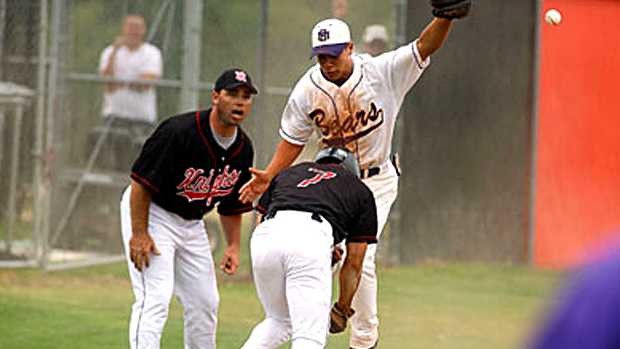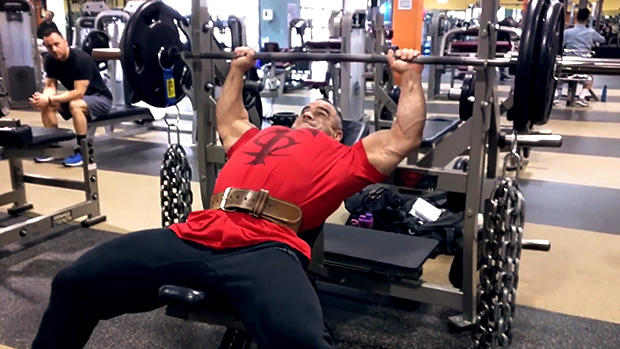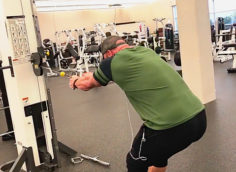When I moved to Boston in the summer of 2006, one of the first
things I did was pull together a network of professionals to whom I
could refer clients.
Manual therapists were a piece of cake. Boston has some of the
best soft tissue guys in the world. Doctors weren't a problem,
either. There are some excellent orthopedic specialists in this
neck of the woods.
Physical therapists, on the other hand, made things pretty
interesting. I'm located in close proximity to some of the
wealthiest towns in Massachusetts, so you see a lot of physical
therapists flock to the area. With more disposable income
available, PT's don't have to deal with insurance companies as
often. Ask any PT what his biggest headache is, and chances are
he'll say dealing with insurance companies (well, aside from
ultrasounding the thighs of overweight geriatrics).
After two years of searching, I've established a good network.
But you as a Testosteronereader don't have that luxury when
your shoulder is throbbing. With that in mind, here are seven tips
to help you be an advocate for your cause as you visit a physical
therapist.
<!--  -->
-->
Tip #1: Immobilization Demands Physical and Manual
Therapy.
Over the winter, my girlfriend's sister slipped on some ice
fracturing both her distal tibia and fibula. She had surgery to
insert some pins and screws, and then her lower leg was immobilized
for about ten weeks. After that, she wore a softer boot for two or
three weeks.
Fast forward to April, she came to visit and found herself doing
a lot of walking as we watched a friend run the Boston Marathon.
She limped the entire way and described some pain in her forefoot.
When I asked what her physical therapist had done, she told me, "My
doctor said I didn't need physical therapy."
She learned an important lesson about the medical model: Some doctors are great surgeons who know very little about
physical therapy. Just because you can "get by" without physical
therapy doesn't mean you should try to.
Later that afternoon, I checked out her ankle and she had no
dorsiflexion range of motion. Her ankle was basically locked at 90
degrees. It's no wonder she was having hypermobility-type pain in
the forefoot; she needed to get movement somewhere! If it
hadn't been the forefoot that hurt, it would've been the knee (to
the basketball players in the audience, think about how this
applies to high-top sneakers, ankle taping, and the chronic
patellofemoral pain you're experiencing).
Our bodies are great at compensating. Take a look at spastic
diplegia, the most common kind of cerebral palsy. It causes
spasticity to varying degress in the lower extremities. But what's
interesting is that those with spastic diplegia typically have
normal or near-normal muscle function above the hips. So, these
individuals can substitute quadratus lumborum muscle action to hike
the pelvis and allow for more lateral deviation during gait to "get
by."
I gave her some ankle mobilizations, had her work on her calves,
Achilles, and peroneals (tightened up from walking with so much
external rotation at her foot) with a baseball, and then gave her
the contact info for a good manual therapist in her
area.

Some soft tissue work for the peroneals with, in
this case, a tennis ball.
If you're immobilized for any reason, you should not only be
getting physical therapy to restore neuromuscular function, but
also soft tissue work to free things up in the first
place.
Tip #2: Your Shoulder Pain isn't Just About the Rotator
Cuff.
Hopefully people have come to realize that while the rotator
cuff is where it frequently hurts, it's not always the cause of the
pain. Case in point, in a 2006 study, Kibler et al. reported that
49% of athletes with arthroscopically diagnosed posterior superior
labral tears (SLAP lesions) also have a hip range of motion deficit
or abduction weakness.(2) How often do you see therapists do hip
mobility drills with shoulder rehab patients?
With that in mind, if your shoulder hurts, ask them how their
rehab program addresses each of the following:
1. Scapular stability.
2. Thoracic spine range of motion.
3. Cervical spine function.
4. Breathing patterns.
5. Mobility of the opposite hip.
6. Mobility of the opposite ankle.
7. Overall soft tissue quality.
8. Glenohumeral (ball-and-socket joint) range of
motion.
9. Rotator cuff strength and endurance.
Most therapists will be quite good with #1, #8, and #9. If more
PT's simply added #2 and #7 to the mix, things would come around
much quicker for most patients. The other four are just a
bonus.
Tip #3: MRI's and X-Rays Don't Tell You
Everything.
Courtesy of Dr. Jason Hodges, here's an X-ray of a chronic
rotator cuff tear in a 90-year-old woman. You can't typically see
acute tears on X-rays, but chronic ones show up
easily.

According to Dr. Hodges, "The relevant findings are that the
humeral head is higher than normal (a.k.a. high riding). There's
bone-on-bone contact between the head and the acromion. The
acromion is remodeled with undersurface curvature. The acromion
looks extra white from bony proliferation in response to the
chronic pressure of the head. If you did an MRI, you'd find the
supraspinatus and infraspinatus to be essentially gone from chronic
shredding, thus allowing the head to migrate
upwards."
You want to know the kicker? He concluded his email with, "I
don't know of any shoulder symptoms in this patient. Usually, these
are asymptomatic.î(3)
Yes, folks, that's one-half of the rotator cuff shredded and no symptoms. I guess Great Grandma isn't a good bet to come out
of the bullpen and save tonight's ballgame.
Speaking of pitchers, you'll find labral fraying in every MRI
you do on pitchers' throwing shoulders. But they aren't all
symptomatic.
Likewise, in the past three months, I've had two high school
baseball players come to me with completely "clean" elbows on MRI's
and X-rays, but significant pain when they throw at over 50%
effort. In the first case, three diagnostic tests (one X-ray, two
MRI's) simply missed out on a bone chip floating around in the
joint from a little league fracture four years prior. It was only
"viewable" when the X-ray was performed while the elbow was
actively repositioned by the doctor.
In the second case, the MRI's and X-rays didn't pick up on a
case of gross functional instability. Rather, it took a good
physical therapist to test the supporting ligaments to get to the
root of the problem. Just because an ulnar collateral ligament is
intact doesn't mean that it isn't lax.
Here's a good analogy I've used with my young athletes and their
parents.
Imagine a joint being like a baseball team on a field. You take a
photo (MRI or X-ray) of that team from the stands and it might look
fine. Or, it might look terrible – there's no left fielder,
the pitcher isn't facing the plate, or the third baseman forgot his
glove. Diagnostic imaging picks up the obvious
stuff.

That photo, however, doesn't show how that team thinks, moves,
fields, hits, or throws. That's the stuff you don't see on a MRI or
X-ray: scar tissue, posterior capsule (shoulder) stiffness, poor
force transfer, or varying degrees of instability.
And, perhaps even scarier, Belgian researchers found that MRI
accuracy was 88% and 85% for medial and lateral meniscal tears,
respectively. Of the 100 patients involved, there were 23 patients
with 27 incorrect diagnoses. According to the researchers, "12
(44%) were unavoidable, 10 (37%) equivocal, and 5 (19%)
interpretation errors."
When examined under arthroscopy and compared against the MRI
results, 12 of the 67 (18%) meniscal tears had been missed on the
imaging. The researchers concluded, "Subtle or equivocal findings
still make MRI diagnosis difficult, even for experienced
radiologists.î(4) You're always going to see some false
positives and negatives.
So, with all that said, your best bet is to simply ask doctors
and physical therapists, "Did the diagnostic imaging confirm or
refute your physical examination of my problems?" If you have
pain, and your MRI and X-ray are both negative, that doesn'tmean that you don't have a problem. Likewise, if your
MRI or X-ray is positive, see how it relates to that physical
examination.
Tip #4: Find Out What You Can Do.
As I noted in The
10 Rules of Corrective Lifting, I'm a firm
believer in telling people what they can do, not just what
they can't do.
It's the doctor's job to contraindicate certain activities.
These recommendations are based on what I call the "stupid
factor." Doctors assume that all patients, physical
therapists, trainers, and strength and conditioning coaches are
inherently stupid until proven otherwise.
So, let's say you break a bone in your hand and the doctor tells
you that you can't do any upper body lifting with that arm while
you're in a cast. This recommendation is black and white –
and necessary to accommodate the stupid factor.
However, go to a good therapist, trainer, or coach, and he's
going to have you doing manual resistance lateral raises, prone
trap raises, one-arm presses, horizontal abductions –
basically anything where manual resistance above the elbow can be
provided. In fact, I'm training two athletes right now who had
nerve transpositions done in their elbow and wrist. They've got two
good legs, one good arm, and plenty of core musculature in the
middle that still need a training effect.
We just had a top 100 soccer prospect get started with us and
he's got probably the worst adductor (groin) strain I've ever seen.
In spite of that, he's been able to jump rope and do reverse sled
drags.
The take-home point here is to be an advocate for yourself and
ask what you can do to train the injured limb without interfering
with your recovery. It's the job of the therapist to set guidelines
for you.
Tip #5: Ask if You Can Make Modifications to Your Daily Life to
Ease Pain.
Have you ever met a roofer, floorer, cyclist, or plumber who has
a healthy back?

The reason for their back issues is that lumbar spines really
don't like being stuck in flexion (especially if you add
compression and rotation). Oddly enough, though, these flexion
intolerant people will actually sit in flexion when they aren't
hammering shingles, laying carpet, pedaling, or fighting with the
porcelain gods. It's kind of like a guy leaving work with a
headache to go home to bang his head against a wall.
Not surprisingly, if you put these people in some extension,
they get some relief of their symptoms. A good example is a towel
folded in half and used as a lumbar support in their chair or car.
(Yes, folks, I'm a rocket scientist on the side.)
Tip #6: Ask Why Hamstrings Need to be
Static-Stretched.
I was doing sprint work with some of my baseball guys a month or
so ago, and one of our newer athletes (left-handed batter) said
that he was having some right-sided lower back pain. I checked him
out, and he had very little hip internal rotation on that front leg
(it's very important to have lead-leg internal rotation for both
throwing and hitting in baseball). I gave him a mobilization to do,
and didn't hear anything more of it for a few weeks. Until he
walked in claiming that he had "pulled his hamstring" down by the
knee.
I'm not a diagnosis guy, but I said to Tony Gentilcore that my
hunch was that it wasn't a hamstring strain at all. The way he
presented made it seem more and more like a case of neural tension.
Basically, a little nerve impingement at the spine radiates some
pain down into the leg. Strains that far down the hamstring aren't
as common as the ones closer to the glutes.
And, here's the interesting part: He was pain free on any
exercise that didn't involve much compressive loading (i.e.
dumbbell lunges vs. squat variations). The added compression would
push on that nerve a bit, and he thought the hamstring was going to
go. Conversely, he had no problem doing any single-leg movement,
which would put some stress on that hamstring.
We worked around it that Thursday, and on Friday, while playing
first base, he jumped to catch a throw and took the baserunner's
shoulder right in his ribs. That night, he was in the emergency
room with a broken rib and punctured lung.
<!--  -->
-->
Believe it or not, it only amounted to four days of downtime for
him, as apparently, lungs can re-inflate fast, and the rib wasn't
symptomatic at all (they never confirmed it on an X-ray, anyway).
So, he got the go-ahead to return to play. Interestingly, his
hamstring issue was nowhere to be found. As those of you who've
ever had a hamstring strain can attest, they don't just magically
disappear.
So what happened? He got some downtime from the rib and lung
issues, and got antsy because he couldn't do any exercise. He then
decided to actually start doing the stretches I gave him. Loosen up
the hips, remove the offending stimulus for a few days, and then
get back to hitting and throwing when the inefficiency is resolved.
Funny how that works.
How does this all relate to stretching the hamstrings?
Well, a lot of back pain is because people are stuck in anterior pelvic
tilt and a lordotic posture. Typically, this entails weakness in the
glutes, rectus abdominus, and external obliques. All of which can
keep someone in posterior pelvic tilt.
However, what many people don't realize is that the hamstrings
are also posterior tilters of the pelvis, even if they aren't the
most mechanically efficient of the bunch. They might be the only
muscles exerting any posterior tilting action on the pelvis. Do you
think that having tight hamstrings might be the only thing that
prevents people with nagging back pain from going to debilitating
back pain?
This is why stretching the hamstrings can sometimes do more harm
than good. If it's just muscular tension, the risks can outweigh
the benefits (assuming they're using enough glutes, external
obliques, rectus abdominus, and there's adequate length of the hip
flexors). However, if it's neural tension, you can be putting a
pissed off nerve on a stretch. Isn't it interesting how closely a
slump test – a provocative test for neural problems –
closely resembles a hamstrings stretch?

The slump test (my apologies for the dude in his
undies).
Plus, if a guy has weakness in the aforementioned muscles, and
you stretch (temporarily weaken) the hamstrings, you've basically
lost the only stabilizer that can actually posteriorly tilt the
pelvis (very important for avoiding stress fractures, groin
strains, spondylolisthesis, etc.).
For a lot of you, this anatomy stuff probably doesn't make a lot of
sense, but at the very least, it shows that having strong (and
possibly tight) hamstrings might be the only thing protecting guys
who are tight in their hips. It's one reason why I favor
conservative mobilizations over static stretching if I'm going to
do anything at all for hamstrings length.
So, just ask your therapist what the rationale for stretching
the hamstrings out is. It might be justified, but the only way
you'll know is if you ask.
Tip #7: Make Sure They Check the Ankles and Discuss
Footwear.
The ankles and feet are the root of a lot of the problems
further up the kinetic chain – lower back pain, in
particular. John Pallof, a physical therapist in my neck of the
woods, once described the subtalar joint as a
"torque-converter." Basically, it takes tri-planar movement
(pronation and supination) at the ankle and below and converts it
to tibial and femoral internal rotation. It's the reason that the
function of your foot can change the positioning of the head of
your femur in your hip "socket."
For simplicity's sake, let's just assume that pronation (what we
do to decelerate) is going to correspond to more internal rotation
of the tibia and femur. This means that you're going to need more
strength in the external rotators of the hip to decelerate that
movement. So, think gluteus maximus, piriformis, biceps femoris,
and a bunch of smaller, deep external rotators.
Now, let's take the typical 35-year-old female. She wears high
heels (drive more pronation), has weak hamstrings (physiological
difference between men and women), hasn't fired her glutes in the
ten years since she started sitting at a desk all day, and spends
three hours per week on the stairmaster and elliptical (stuck in
anterior pelvic tilt).
If she doesn't get ankle, hip, or knee issues first, it's easy
to see why piriformis would act up (small muscle doing a big job by
itself) or she'd start to get extension-based back pain (no glutes
to pull her into posterior tilt to resist the anterior
weight-bearing she's imposed).
Closing Thoughts
I don't want to leave you with a bad taste in your mouth about
the medical community, so I'll conclude with this: There are
someincredible health care professionals out there. As with
any profession, there are others who just opt to punch the clock
instead of really caring about the work they do.
It's up to you to develop your go-to network and to do so today.
It's better to know who you're going to contact when you get
injured than it is to scramble to find someone on a moment's notice
when you're already in pain. Start asking around and find someone
who's good at what they do.





